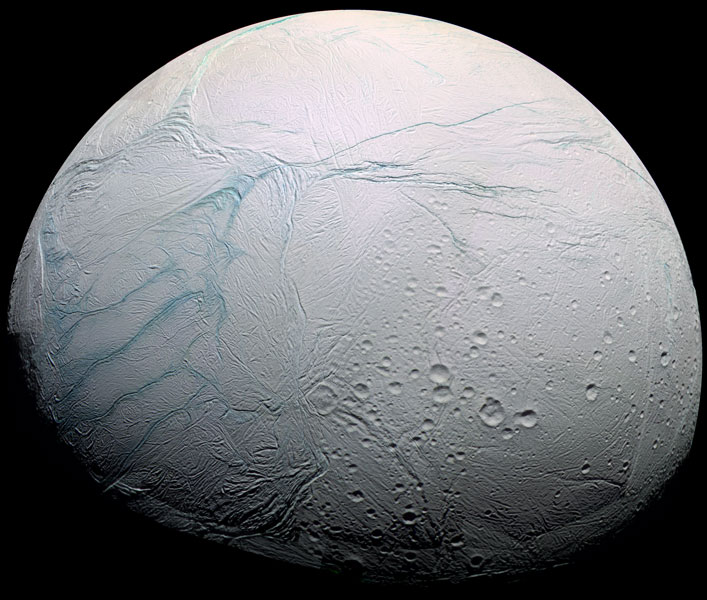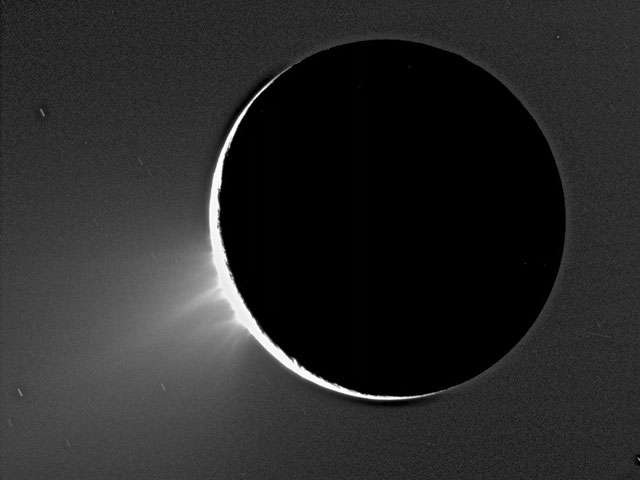The blue-green tiger stripes on Saturn's moon Enceladus might be active. Even today, they may be spewing ice from the moon's icy interior into space, creating a cloud of fine ice particles over the moon's South Pole and creating Saturn's mysterious E-ring. Recent evidence for this has come from the robot Cassini spacecraft now orbiting Saturn. Cassini detected a marked increase in particle collisions during its July flyby only 270 kilometers over a South Polar region of Enceladus. Pictured above, a high resolution image of Enceladus is shown from the close flyby. The unusual surface features dubbed tiger stripes are visible on the left in false-color blue. Why Enceladus is active remains a mystery, as the neighboring moon Mimas, approximately the same size, appears quite dead. (Image credit: Cassini Imaging Team, SSI, JPL, ESA, NASA)On Saturn’s Enceladus Moon, ‘Good News For Any Hypothetical Organisms Out There’
Erupting geysers have scientists thinking ‘subsurface ocean’
In the search for signs of extraterrestrial life, scientists are increasingly intrigued by ongoing findings from the Saturn mission of NASA’s Cassini spacecraft mission indicating the presence of liquid water reservoirs erupting in Yellowstone-like geysers on the moon Enceladus. Consequently, Enceladus has been confirmed as only the third extraterrestrial world to be geologically active.
"We realize that this is a radical conclusion--that we may have evidence for liquid water within a body so small and so cold," says Carolyn Porco, Cassini imaging team leader at the Space Science Institute, Boulder, Colo. "However, if we are right, we have significantly broadened the diversity of solar system environments where we might possibly have conditions suitable for living organisms."
Fountains of ice shoot out from Saturn's moon Enceladus. Clear discovery images of the fountains were made using observations from the robot Cassini spacecraft currently orbiting Saturn. During a recent pass, Cassini was programmed to look back toward the Sun where Enceladus would appear as a thin crescent. From this vantage point, particles emitted from the surface would better show themselves by reflecting sunlight. The tactic was successful--the above frame shows several plumes emanating from regions previously known to contain gashes in the surface dubbed tiger stripes. Cassini detected an increase in particle emissions from these regions during a July flyby. Some of these ice particles likely contribute to the make up of Saturn's mysterious E ring. (Image credit: Cassini Imaging Team, SSI, JPL, ESA, NASA)The rare occurrence of liquid water so near the surface raises new questions about this mysterious moon. High-resolution images of Enceladus recorded by the Cassini spacecraft, combined with a model of jet activity, reveal jets of water vapor and ice shooting from the south pole of Enceladus that have been active for up to 100 million years, boosting the odds that the moon harbors a liquid ocean beneath its icy surface. If the existence of such an ocean is confirmed, Enceladus will become one of the most promising places in the solar system in which to search for signs of extraterrestrial life.
Scientists examined several models to explain the process. They ruled out the idea of particles being produced or blown off the moon's surface by vapor created when warm water ice converts to a gas. Instead, scientists have found evidence for a much more exciting possibility. The jets might be erupting from near-surface pockets of liquid water above 0 degrees Celsius (32 degrees Fahrenheit), like cold versions of the Old Faithful geyser in Yellowstone.
"We previously knew of at most three places where active volcanism exists: Jupiter's moon Io, Earth, and possibly Neptune's moon Triton. Cassini changed all that, making Enceladus the latest member of this very exclusive club, and one of the most exciting places in the solar system," says John Spencer, Cassini scientist, Southwest Research Institute, Boulder.
This NASA video explains the significance of data collected on the Cassini mission’s flybys of the Saturn moon Enceladus"Other moons in the solar system [may] have liquid-water oceans covered by kilometers of icy crust," says Andrew Ingersoll, imaging team member and atmospheric scientist at the California Institute of Technology, Pasadena, CA. "What's different here is that pockets of liquid water may be no more than tens of meters below the surface."
"As Cassini approached Saturn, we discovered the Saturnian system is filled with oxygen atoms. At the time we had no idea where the oxygen was coming from," says Candy Hansen, Cassini scientist at NASA's Jet Propulsion Laboratory (JPL) in Pasadena. "Now we know Enceladus is spewing out water molecules, which break down into oxygen and hydrogen."
The Cassini images depict a blanket of snow-like material that has all but erased old surface fractures and rounded the sharp edges of canyon rims on some parts of Enceladus.
This image shows a high-resolution heat intensity map of part of the south polar region of Saturn's moon Enceladus, made from data obtained by NASA's Cassini spacecraft. The map reveals never-before-seen details of warm fractures that branch off like split ends from the ends of the main trenches of two ‘tiger stripes.’ The features nicknamed ‘tiger stripes’ are long fissures that spray water vapor and icy particles. These two fissures, Cairo Sulcus (left) and Alexandria Sulcus (right), extend to the lower right, off the bottom of the image. The map also shows an intriguing isolated warm spot, shown in purple-red in the upper left of the image, that is separated from other active fissures. The thermal data came from Cassini's composite infrared spectrometer during an Aug. 13, 2010, flyby of Enceladus. Scientists overlaid the data on a background map of that region made from Cassini images taken in July 2005. The intensity of thermal radiation, measured at wavelengths from 12 to 16 microns, is color-coded, with dark blue, purple, red and orange denoting progressively more intense radiation, due to higher temperatures and/or larger expanses of warm material. The pale blue color indicates regions that were mapped but that were too cold to emit significant radiation. Alignment of the thermal map with the underlying base map is approximate. The map shows a region approximately 130 kilometers (80 miles) across. (Image credit: NASA/JPL/GSFC/SWRI/SSI)The blanketing material is in two strips running from south to north on opposite sides of the moon, and its bluish colour is a perfect match for the ice particles from the plumes that are predicted to fall as snow on Enceladus. This is only a fraction of the plume material; most of the ice goes to feed the outermost of Saturn's rings, the E ring, as described by Sascha Kempf, a planetary scientist at the Max Planck Institute for Nuclear Physics in Heidelberg, Germany, and Jürgen Schmidt, a researcher in celestial mechanics at the University of Potsdam, Germany, in Icarus last year.
The fine powder of ice crystals falls on Enceladus at a miniscule average rate of less than one thousandth of a millimeter per year, according to Kempf and Schmidt's calculations. Yet when Schenk and his colleagues examined high-resolution stereo images, they found that in one region near the moon's south pole, the blanket of snow is about 100 meters thick, indicating that the plumes must have been active for tens of millions of years.
‘Suddenly, Enceladus, one of the smallest objects in the Saturnian system, has become one of its biggest mysteries’: A Scientific American video detailing the history of Enceladus exploration, beginning with 1980’s Voyager mission and including the initial announcement confirming the existence of the south pole geyser activity as revealed in 2005’s Cassini mission.The extended lifetime of the jets, which shoot out of warm vents at the south polar region, indicates that the heat source driving them must have also been around for a while. "A long-lived heat source could make it easier to maintain a liquid layer inside the moon,” from which water could be forced out through cracks in the surface ice as plumes, says Paul Schenk, a planetary scientist at the Lunar and Planetary Institute in Houston, TX. This past October Schenk appeared before a joint meeting of the European Planetary Science Congress and the American Astronomical Society's Division for Planetary Sciences in Nantes, France, to present findings from a study of Enceladus he and his colleagues have conducted. Kempf, Schmidt and their colleagues have previously reported evidence for a salty ocean beneath the moon's surface.
John Spencer, a planetary scientist at the Southwest Research Institute in Boulder, Colorado, says that the deep snow deposits don't necessarily indicate the presence of an ocean inside the moon, but "a long history of activity does make long-term persistence of water more likely, and that has to be good news for any hypothetical organisms out there.”
For more information about the Cassini-Huygens mission visit www.nasa.gov/cassini or http://saturn.jpl.nasa.gov/
Founder/Publisher/Editor: David McGee
Contributing Editors: Billy Altman, Laura Fissinger, Christopher Hill, Derk Richardson
Logo Design: John Mendelsohn (www.johnmendelsohn.com)
Website Design: Kieran McGee (www.kieranmcgee.com)
Staff Photographers: Audrey Harrod (Louisville, KY; www.flickr.com/audreyharrod), Alicia Zappier (New York)
E-mail: thebluegrassspecial@gmail.com
Mailing Address: David McGee, 201 W. 85 St.—5B, New York, NY 10024





